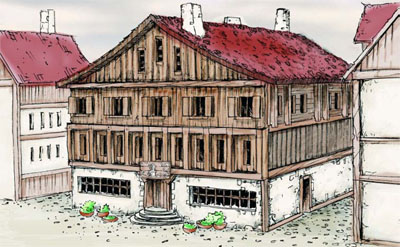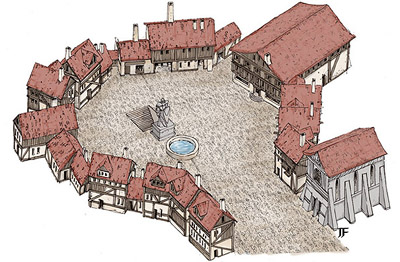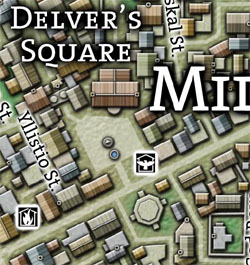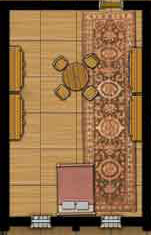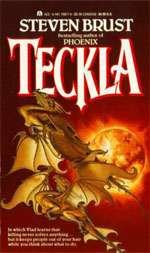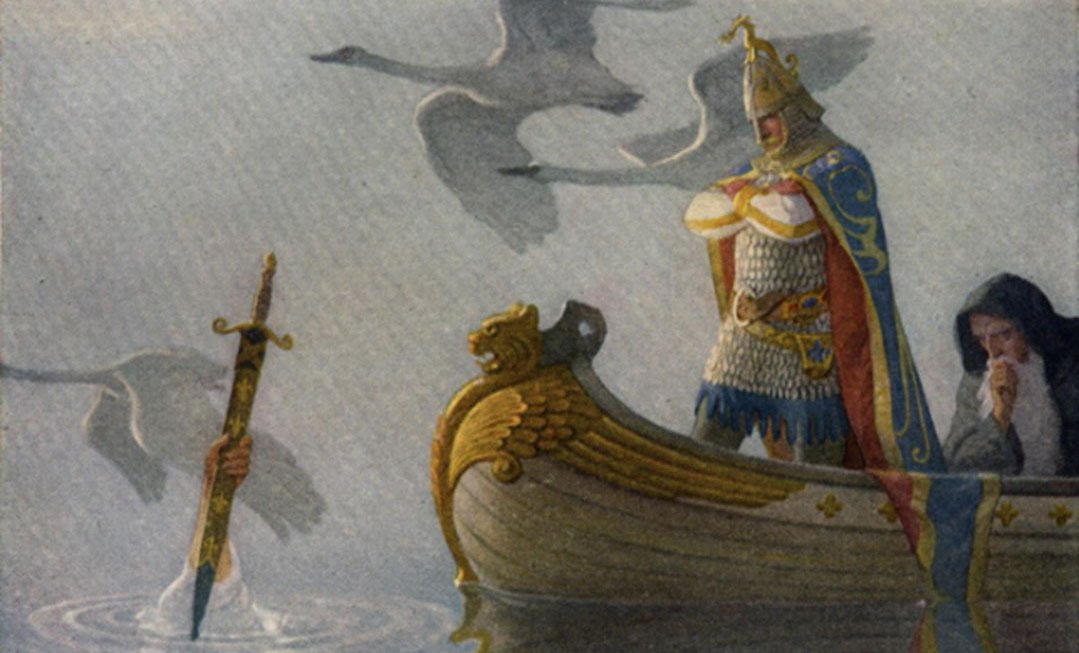
D&D — and roleplaying games in general — have always struggled with magic.
Elrond knew all about runes of every kind. That day he looked at the swords they had brought from the trolls’ lair, and he said, “These are not troll-make. They are old swords, very old swords of the High Elves of the west, my kin. They were made in Gondolin for the Goblin-wars. They must have come from a dragon horde or goblin plunder, for dragons and goblins destroyed that city many ages ago. This, Thorin, the runes name Orcrist, the Goblin-cleaver in the ancient tongues of Gondolin; it was a famous blade. This, Gandalf, was Glamdring, Foe-hammer that the king of Gondolin once wore. Keep them well!” — The Hobbit by J.R.R. Tolkien
Nifty.
Player: We search the trolls’ lair.
DM: You find a +1 goblin-bane longsword and a +3 longsword.
Less nifty.
Some would conclude from this that D&D just doesn’t do magic very well. After all, what’s magical about a +2 bonus to attack rolls or a +5 bonus to Hide checks?
But let’s consider this problem from another angle.
He saw a tall, strongly made youth standing beside him. This person was as much out of place in that den as a gray wolf among mangy rats of the gutters. His cheap tunic could not conceal the hard, rangy lines of his powerful frame, the broad heavy shoulders, the massive chest, lean waist, and heavy arms. His skin was brown from outland suns, his eyes blue and smoldering; a shock of tousled black hair crowned his broad forehead. From his girdle hung a sword in a worn leather scabbard. — “The Tower of the Elephant” by Robert E. Howard
Also nifty.
DM: Someone taps you on the shoulder.
Player: I turn to look. Who is it?
DM: A 3rd-level barbarian with a sword.
Similarly less nifty.
What are we supposed to conclude from this? That roleplaying games are just abject failures? That they suck all the life and mystery and grandeur from the world?
Well, they certainly can do that. If you let the numbers become the game world, then that seems to be the inevitable result. But I think we’re only looking at half the story here. In my opinion, the numbers inherent to a roleplaying system are only a means to an end. They shouldn’t be confused with the game world — they are merely the means by which we interface wtih the game world.
So, yes, the blade we found in the troll lair was, in fact, a +1 goblin-bane longsword. That doesn’t change the fact that it is also Orcrist, the Goblin-cleaver of Gondolin — a legendary blade lost to the elves when that proud city fell to dragons and orcish hordes.
The numbers are only empty and meaningless if you leave them that way. If you fill them with meaning (or start with the meaning and work your way back to the numbers), the problem goes away.
With that thought in mind, here are a few methods for spicing up your magic items.
HOW DOES THE MAGIC WORK?
Mechanically, a +2 longsword magically gives you a +2 bonus to your attack and damage rolls.
Okay, but what does that mean? Is the blade preternaturally sharp? Does the magical enhancement guide your thrusts? Does it grant you a moment of combat-oriented prescience at the moment you begin to swing your blade, allowing you to see the outcome of the stroke and adjust it accordingly? Is it perfectly balanced, yet light and lively in your hand? Does the edge of the blade morph from diamond sharpness (for piercing armor) to vicious serrations (to rip and tear at flesh) in the middle of a blow? Can you feel the tendril of its mystic energy reaching into your mind and there implanting the arcane combat techniques of the Obsidian Brothers — techniques that you can scarcely comprehend? Does your arm grow in strength and speed when you hold the blade? Does the blade glow with a light that only you can see, but which seems to limn your targets in crystal clarity?
In my current campaign, one of the PCs has a ring of lockpicking (+5 bonus to Open Lock checks). The ring has a large ruby that can be slid to one side, revealing a nest of miniature tools. The wearer of the ring can mentally manipulate these incredibly precise tools (hence granting the bonus to their skill checks).
But you could just as easily have a ring of lockpicking that grants the wearer an encyclopedic knowledge of locks; or allows the wearer to psychically “feel” the mechanisms of the lock; and so forth.
The difference between a ring that grants an enhancement bonus in some vague and unspecified way (“’cause it’s magic”) and a ring filled with magically-crafted tools that you can control through the power of your mind is a vast gulf of detail and personality. And having a firm understanding of not only what the item does, but how it does it, can turn every use of that item into a flavorful and memorable event.
NAMES
Nobody remembers Magic Sword #3419. But if I say “Sting”, you probably think Frodo. And if I say “Stormbringer”, you probably think Elric.
Naming an item immediately makes it unique. It also gives the item an identity, which means that the item will immediately begin accumulating lore to itself — every time something interesting or memorable happens involving the item, it has a name that can be latched onto that event.
There are basically two ways for an item to gain a name:
(1) Lore. Like Glamdring or the Ruby of the North, the item may have been given a name before it ever comes into the hands of the PCs. This lore-born name can be imparted to them in many ways — perhaps the ogre wielding the weapon cries the name aloud; or the item whispers it in their ear when they first claim it; or a loremaster identifies it; or they were questing for it; or they know it themselves (from a successful skill check).
(I just made up the name “Ruby of the North”, but it made you wonder what it was, didn’t it?)
(2) New. Encourage the players to name items that are important to them, or seize opportunities to immortalize memorable events in the game by naming the items responsible for them. When a sword becomes Gnoll-Render because of the PCs ripping out the entrails of the gnoll chieftain… well, that’s pretty awesome.
UNIQUE APPEARANCE
If magic items look generic, then they’ll be treated generically. If +2 longswords just look like every other sword (or even if every +2 longsword just looks like every other +2 longsword), it doesn’t matter how rare they are — they’re still going to be treated as nothing more than a stat block.
For example, several months ago one of the PCs in my campaign went down to the local magic shop to buy a magic sword. What could be more generic, right?
When they first arrived in the shop and started talking about weapons, the shopkeeper showed them several magetouched weapons that had recently been recovered from the depths beneath the city. But when it became clear that they were seeking something a little more notable, he smiled enigmatically and went into a backroom.
He emerged with a long, slim blade. The steel was filigreed with gold and the hilt was of finely curved silver. He ran his hand gently down the length of the blade, as if caressing a lover. “The markings here upon the blade are not merely gold, but taurum — the true gold, mined from the Mountains of the East. And there is a thin core of it in the heart of the hilt. The enchantment worked upon this blade sings from the taurum, and its name is Nainsyr.”
At the word, blue lightning sprang from the hilt and rang along the length of the blade — crackling with a vicious smell of ozone.
“It’s an elvish word. It means, ‘Let there be lightning.’ And, indeed, the blade is old. It shows the marks of an elvish craft that I have rarely seen.”
It’s a +1 shock longsword. And it was bought in a store. But it’s his sword. The players remember who they bought that sword from. They remember the first time the PC used it in combat.
Another example from my campaign is a bag of holding elegantly crafted from black velvet that was given to the party as part of their payment for a job well done. This unique little touch might not seem like much, but not only do the players distinctly remember receiving that payment, the player who carries the bag of holding has actually passed up the opportunity to get larger bags of holding simply because they like this one so much.
HISTORY
Glamdring and Orcrist have a history to them. They existed before they came into the hands of the heroes. They are spoken of in tales.
Giving a magic item a unique history — much like naming them — helps to give the item an identity. It can also make the players feel like their characters are inheriting a meaningful legacy or a sacred trust. It gives the item meaning, purpose, and context. This item is not merely a tool; it is a thing of note.
MECHANICS
Most of this essay has dealt with how to make magic items feel special and magical in spite of the mechanics. But you can also turn the mechanics to your own use.
For example, +1 shock longsword is not only mechanically more interesting than a +2 longsword, that special ability also gives you something to latch onto while using the other techniques described here. (For example, Nainsyr’s taurum filigree and name are all derived from its special ability.)
Items which feature an interesting package of abilities or a quirky side-effect can be notably unique. A ring of water-breathing that turns the skin of the wearer blue; an amulet of health that causes the user to exude a golden glow (with the effect of a light spell); winged boots that spontaneously generate a cloud of butterflies that flutter around the user; a fist-sized ruby that functions as both a crystal ball and a gem of seeing; and so forth.
MANAGING THE DETAILS
All of this advice can really be boiled down to a simple maxim: Life is in the details.
The difference between a cold, lifeless stat block and a memorable myth is all about the living details that you imbue your game world with.
But supplying this detail can seem a little overwhelming. Do I really expect you to give every magical item a clever mechanism of operation; an interesting name; a unique appearance; and a fully detailed history?
No, actually, I don’t. In fact, unless your campaign is extremely light on magical items, that would be a really bad idea. Not only will you end up overloading your players with details (to the point where they’ll just start tuning it out), but when everything is special and unique nothing ends up being special and unique.
In a magic-rich environment, not all magic needs to be unique or clever. For example, in my own campaign there are plenty of two-bit wizards who lay minor enchantments and charms onto blades. These “magetouched weapons” (as I call them) are, figuratively speaking, a dime a dozen. They’re magically sharp and strong, but they’re not particularly remarkable.
The other thing to remember is that you don’t actually have to do that much work. It’s easy to over-think things, but there’s really no need to prep a three page (or even three paragraph) description of a magic item.
Take Nainsyr for example. It has a little bit of history to it: It’s an old blade of rare elven craft and it was found by delvers plumbing the cavernous depths beneath Ptolus. That type of detail is easy to improvise (and, in fact, it was improvised — I didn’t know they were planning to go shopping).
That may not seem like a lot of history to you, but take a second look at Gandalf’s Glamdring: It seems to echo with history, but the only thing Tolkien actually tells you about it is, “It was worn by the king of Gondolin. It might have been taken by goblins or dragons during the sacking of that city.”
Tolkien lets your imagination run wild with that. Feel free to let your players do the same.
And did you notice how Tolkien doesn’t actually give the history of those weapons until after the heroes have already decided to wield them? Let the players tell you what they care about before you spend time working out the details.
MINOR MAGIC
As a a final word, let me point out that not all magic has to be usable. (Or, at the very least, usable by adventuring PCs.)
A small, well-worn stone that grows warm to the touch when you rub it. A poppet that moves and speaks when placed in the arms of a virgin. A skull that crumbles to dust when touched by living flesh, but then reforms itself over the course of 13 hours. A glass eye that rotates and spins when left unattended (in an eyesocket it rotates to perfectly mimic a living eye, although it conveys no gift of sight). A blindfold that can be seen through as if it wasn’t there.
Some such items might be assigned some sort of market value (and, thus, become part of the treasure — albeit more interesting treasure than just X number of gold pieces). But their real function is to fill the world with a little bit of magic that just can’t be boiled down to, “What can I do with it?”
Sometimes magic is just… magical. It’s not there to be used as a weapon or beaten into a plowshare. It’s just there for the sake of being.
And when that type of magic permeates your campaign world — when wonders are there to be found… Well, that’s when you get magic in your magic items.

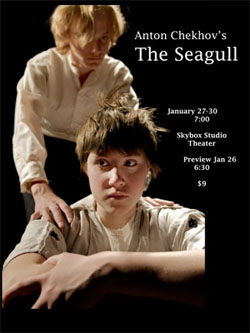 When I was first asked to return to my alma mater to direct a play as part of their 2008-2009 season, I started reading plays. And reading plays. And reading plays.
When I was first asked to return to my alma mater to direct a play as part of their 2008-2009 season, I started reading plays. And reading plays. And reading plays.
